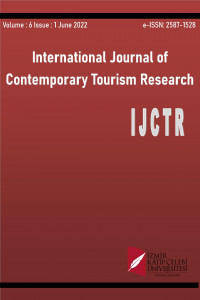Yiyecek İçecek İşletmelerinde Algılanan Gıda Güvenliğini Etkileyen Faktörlerin Belirlenmesine Yönelik Bir Araştırma
Yiyecek İçecek İşletmeleri, Gıda Güvenliği, Algılanan Gıda Güvenliği
A Research on Determination of Factors Affecting Perceived Food Safety in Food and Beverage Enterprises
___
- Aksoydan, E. (2007). Hygiene Factors Influencing Customers' Choice of Dining‐Out Units: Findings From A Study of University Academic Staff. Journal of Food Safety. 27(3): 300-316.
- Amjadi, K. ve Hussain, K. (2005). Integrating Food Hygiene into Quantity Food Production Systems. Nutrition & Food Science, 35(3): 169-183.
- Bai, L., Wang, M., Yang, Y. ve Gong, S. (2019). Food Safety in Restaurants: The Consumer Perspective. International Journal of Hospitality Management. 77: 139-146.
- Barber, N. ve Scarcelli, J. M. (2009). Clean restrooms: How İmportant are They to Restaurant Consumers? Journal of Foodservice. 20(6): 309-320.
- Cha, J. ve Borchgrevink, C. P. (2019). Customers’ Perceptions in Value and Food Safety on Customer Satisfaction and Loyalty in Restaurant Environments: Moderating Roles Of Gender And Restaurant Types. Journal of Quality Assurance in Hospitality and Tourism. 20(2): 143-161.
- Ertürk, M. (2018). Tüketicilerin Dışarıda Yemek Yeme Nedenleri. Gaziantep University Journal of Social Sciences. 17(3): 1203-1224Fatimah, U. Z. A. U., Boo, H. C., Sambasivan, M. Salleh, R. (2011). Foodservice Hygiene Factors-The Consumer Perspective. International Journal of Hospitality Management. 30(1): 38-45.
- FDA (2006). (Food and Drug Administration ) Managing Food Safety: A Regulator's Manual For Applying HACCP Principles to Risk-based Retail and Food Service Inspections and Evaluating Voluntary Food Safety Management Systems, April2006https://www.fda.gov/food/hazard-analysis-critical-control-point-haccp/managing-food-safetyregulatorsmanualapplying-haccp-principles-risk-based-retailandfoodservice. (30.04.2019).
- Fornell, C. ve Larcker, D. F. (1981). Evaluating Structural Equation Models With Unobservable Variables and Measurement Error. Journal of Marketing Research. 18(1): 39-50.
- Gastro, (2019). Gıdaların Yüzde 72’si Çöpe Gidiyor. 18.06.2019. http://www.gastrofests.com/gidalarin-yuzde-72si-cope-gidiyor/ (05.08.2019)
- Henson, S., Majowicz, S., Masakure, O., Sockett, P., Jones, A., Hart, R. ve Knowles, L. (2006). Consumer Assessment of the Safety of Restaurants: The role of İnspection notices and Other Information Cues. Journal of food Safety, 26(4): 275-301.
- Koçak, N. (2010). Yiyecek İçecek İşletmelerinde Gıda ve Personel Hijyeni. Ankara: Detay Yayıncılık.
- Leach, J., Mercer, H., Stew, G. ve Denyer, S. (2001). Improving Food Hygiene Standards–a Customer Focused Approach. British Food Journal. 103(4): 238-252.
- Liu, P., ve Lee, Y. M. (2018). An Investigation of Consumers’ Perception of Food Safety in The Restaurants. International Journal of Hospitality Management, 73: 29-35.
- Nguyen, T., Wilcock, A. ve Aung, M. (2004). Food Safety and Quality Systems in Canada: An Exploratory Study. International Journal of Quality & Reliability Management, 21(6), 655-671.
- Özdoğan Y.Ş. (2014). Gıda Güvenliği ve Yeni Yaklaşımlar, Yiyecek İçecek Endüstrisinde Trendler, Kavramlar, Yaklaşımlar, Başarı Hikayeleri (ss. 127-140) Editör Özdoğan O.N. Ankara: Detay Yayıncılık.
- Park, H. (2015). Impact of Restaurant Sanitation on Consumer Perceptions, Emotions, and Behavioral Intentions (Yayınlanmamış Doktora Tezi). Indiana: Purdue University Graduate School of Social Sciences.
- Park, H., Almanza, B. A., Miao, L., Sydnor, S. ve Jang, S. (2016). Consumer Perceptions and Emotions About Sanitation Conditions in Full-Service Restaurants. Journal of Foodservice Business Research. 19(5): 474-487.
- Retail Türkiye (2018). Dışarıda Yemek Yeme Oranı %65, Kişi Başı Ortalama harcama ise 30 TL. 08.01.2018. https://www.retailturkiye.com/genel-haberler/disarida-yemek-yeme-orani-65-kisi-basi-ortalama-harcama-ise-30-tl (04.08.2019)
- Schumacker, R. E. ve Lomax, R. G. 2004. A Beginner's Guide to Structural Equation Modeling (2nd Ed.). Mahwah, NJ, US: Lawrence Erlbaum Associates Publishers.
- Stylidis, D. (2016). The Role of Place Image Dimensions in Residents' Support for Tourism Development. International Journal of Tourism Research. 18(2): 129-139.TAVAK (2018). Türkiye’de Yeme-İçme Sektörünün Boyutları Gastronomi Ekonomisi Ara Rapor 2018 https://tavakvakfi.org/ekonomi/gastronomi-ekonomisi-2018/ (15.04.2019).
- Ural, A. ve Kılıç, İ. (2011). Bilimsel Araştırma Süreci ve SPSS ile Veri Analizi. Ankara: Detay Yayıncılık.
- Wall, E. A. ve Berry, L. L. (2007). The Combined Effects of The Physical Environment and Employee Behavior on Customer Perception of Restaurant Service Quality. Cornell Hotel and Restaurant Administration Quarterly. 48(1): 59-69.
- WHO (2019). Food Safety Key Facts. https://www.who.int/en/news-room/fact-sheets/detail/food-safety (19.04.2019).
- Worsfold, D. (2006). Eating Out: Consumer Perceptions of Food Safety. International Journal of Environmental Health Research. 16(03), 219-229
- Yazıcıoğlu, Y. ve Eroğan, S. (2011). SPSS Uygulamalı Bilimsel Araştırma Yöntemleri. Ankara: Detay Yayıncılık.
- Başlangıç: 2016
- Yayıncı: İzmir Katip Çelebi Üniversitesi
Tüketicilerin Kahve Tüketim Alışkanlıkları ve Kahve Dükkanı Tercihleri: Antalya İlinde Bir Araştırma
SWOT-TOWS Analysis of Urla Destination’s Alternative Tourism Development
İge PIRNAR, Sinem KURTURAL, Engin Deniz ERİŞ
Burhanettin ZENGİN, Gökhan GENÇ
How Influential Are Travel Websites On Travelers’ Travel Planning? An Empirical Research in Turkey
Yerel Halkın Kültürel Miras Farkındalığı ve Deneyimi: Şanlıurfa Örneği
Çerkes Mutfak Kültürünü Deneyimlemeye Yönelik Bir Tur Önerisi: Düzce İli Örneği
Vedat ACAR, Kağan KARAOSMANOĞLU
Örgüt İçi İletişimde Finansal Verilerin Kullanımlarının Belirlenmesi: Otel İşletmeleri Örneği
Doğan ÇAPRAK, Tuğba UÇMA UYSAL
Domestic Tourists’ Unethical Behaviors in Package Tours
Mahmut EFENDİ, Gülnur KARAKAŞ TANDOĞAN
Turizm Rehberliği Alanında Yapılan Makalelerin Bibliyometrik Analizi
